Commercial publishing became established as a profession and expanded dramatically during Japan’s Edo period (1600–1868). Large quantities of woodblock-printed material were produced to meet a broad and literate readership. Woodblock-printed books are an invaluable, indispensable source in any discussion of Edo-period culture, be it the areas of literature, history, religion, academia, pedagogy, entertainment, or the arts. And yet, we often overlook the fact that an integral component in the making of these books was the printing blocks themselves and that a sophisticated technology was developed in their use. However, different from the books themselves, which have been comparatively well studied and documented, one has the sense that the printing blocks employed in their production have been left behind in our appreciation of Edo-period publishing culture. They do merit study in their own right, and this essay will outline aspects of printing blocks (hangi 板木) in an attempt to redress this gap in our understanding.
Shomotsu and Sōshi: Printing Blocks and Publishing Rights
One consequence of the rapidly growing publishing industry in the Edo period was that the demand to re-print previously issued work, including books, also increased. For publishers, using the medium of woodblock printing was preferable to the technology of movable type (also known in Japan at this time) since printing blocks could be stored and reprinted for future publications. By contrast, movable type required the resetting of type for each new edition. 1
To us modern-day viewers the appearance of woodblock-printed books might appear uniform despite clear variations in style, genre, and subject. But during the Edo period publishers made a distinction in the categorization of books between shomotsu (書物) and sōshi (草紙). Generally speaking, shomotsu were seen as books having a more serious content with greater educational value for a broad audience and targeting an adult male readership, whereas sōshi were regarded as more lightweight in content and mirrored the latest trends in the society, manners and customs of the era. (The Pulverer Collection is well represented in sōshi; see e.g., Ehon chūshingura FSC-GR-780.219.) While many sōshi seem to have been intended for women and children (and many books make this claim in their prefaces), a broad audience did read sōshi. 2 Many illustrated books were made in this genre, as may be seen in the Pulverer Collection.
However, the line separating shomotsu and sōshi in terms of content is not always well defined. If a clear line could be drawn it would most likely hinge on the establishment of hankabu (板株) rights. This is a critical term. Although hanbaku has the literal meaning of “block stock” it in fact covers the publishing rights that come with the possession of the woodblocks.
Possessing the printing blocks for shomotsu publications was synonymous with owning the publishing rights. In other words, the value of the printing blocks for shomotsu publications was not limited to their role as printing tools: the blocks were also regarded as embodying intangible rights due to their contents. By contrast the printing blocks for sōshi, with their higher entertainment value, do not survive at that same rate. It may have been the case that these blocks were not as carefully preserved because they were regarded more as tools in the printing process and did not represent the content as an asset. It is also possible that they were considered so ‘trendy’ and ‘of the moment’ that their content would have no lasting value, or perhaps the blocks became so worn that they were of no further use. Thus, it is not surprising that the majority of surviving printing blocks are for shomotsu and that these were safeguarded as assets (or rights). This essay will provide an introduction to these objects through a study of shomotsu printing blocks. It should also be added that a similar examination of the woodblocks is relevant to the works in the Pulverer Collection, which principally comprises sōshi publications (see e.g., Imayō shokuninzukushi uta-awase FSC-GR-780.345; inside back cover).
The Structure of Printing Blocks for Printed Books
Printing Block Formats
The intended size for a book determined the shape and size (formats) of the printing blocks. These blocks were typically made from wild cherry wood. However, the number of sheets (cho 丁) that a single printing block could accommodate was likewise a determining factor.
In the Edo period the majority of printing blocks fall into two categories. The most common practice was to align two sheets (one on the left, the other on the right) contiguously on one side of the block such that the total sheet count for both the front and back would be four sheets Fig. 1 and Fig. 2. The next most frequently used block form emerged sometime in the nineteenth century; this type comprised one sheet on each side for a total of two sheets for each block Fig. 3. Other variations produced either six or eight sheets Fig. 4 and Fig. 5, using a narrow rectangular block. However, these narrower blocks constitute only a small proportion of the total number of extant printing blocks, likely because these blocks were difficult to handle during printing and were unwieldy to store. Horizontal format books (yokohon 横本), another commonly seen book type, were made by arranging the sheets vertically on the printing blocks, as may be seen in Fig. 6. This adaptation was no doubt due to reasons of convenience in storage and usage since the side-by-side (left and right) placementof the sheets of a yokohon would otherwise have made the printing blocks too long and narrow.
Hashibami (端食)
In Figs. 1-3 we can see that lengths of wood have been attached to either end of the printing block. These wooden “clamps” are known as hashibami 端食 (literally “holding the edge”) and were used to prevent the block from warping. Hashibami were made of slightly thicker wood than the printing block. Sadly, many surviving printing blocks no longer have these. The printing blocks owned by the Kyoto publisher Hōzōkan (法藏館)—reportedly stored in the same way since the Edo period Fig. 7—shows that the printing blocks were stacked and stored flat. Stacking the blocks in this manner meant that the hashibami also prevented the blocks touching each other and causing damage to the cut areas. Furthermore, the space created between the blocks facilitated aeration and drying.
The methods used to affix hashibami varied over time, and an examination of the ends of a printing block helps to determine when the printing block was made, or at least gauge its relative age (newer or older). The oldest type, employed until around the Kanpō era (1741–1744), involved attaching hashibami to the two convex-shaped (deko 凸) edges of the printing block and securing them with metal nails Fig. 8 and Fig. 9. However, from the mid-1740s onwards, during the Enkyō era (1744–1748), the means of attaching the hashibami changed; the new technique required cutting a dovetailed shape into either end of the block to allow the hashibami to be slid in to the block edge Fig. 10 and Fig. 11. This technique was employed until sometime in the early Meiji period (1868–1912). Thereafter printing blocks were not specially worked to accommodate hashibami; instead, the wooden clamps were simply nailed into the sides of the blocks.
Printing Block Registration: Kentō Marks
Edo-period Japanese seem to have admired woodblock-printed Chinese books such as Jiezhiyuan hua zhuan 芥子園画傳 (J. Kaishien gadan, The mustard seed garden manual of painting; 1679). This likelyprompted them to attempt full-color printing. The challenge with color printing, where each color requires a separate block, is how to prevent misalignment and thus guarantee accurate registration during the printing of multiple colors. Block-cutters developed a system that involved cutting two registration marks (kentō 見当) into the woodblock. These were a right-angled kagi, or “key,” kentō (kagi kentō 鍵見当) at the bottom right corner and a straight hikitsuke, or “drop stop,”kentō (hikitsuke kentō 引き付け見当) at the bottom left corner Fig. 12, Fig. 13, Fig. 14, and Fig. 15 (note that the composition is a mirror image, thus the left and right sides are reversed). This innovation made full-color printing possible. Printing with five or more color blocks came to be known as nishiki-e, or “brocade pictures,” because they were thought to be as beautiful as color silk brocades (nishiki). This technique is used in the full-color books so well represented in the Pulverer Collection.
Kentō were not needed for the printing blocks of the many woodblock-printed books produced only in black ink (sumi 墨). (For color and monochrome versions of the same book in the Pulverer Collection, see Seirō ehon nenjū gyōji FSC-GR-780.327.1-2 and FSC-GR-780.319.1-2, respectively.) Running marks (chūkoku 柱刻) are situatedon the inside edge of a page and contain information such as a shortened title (hashira-dai 柱題) and sheet number (chōzuke 丁付). Close analysis of these marks in a number of printed books reveals that the area below the text frame was realigned during binding. Aligning the paper with the printing blocks must have been necessary to produce sheets ready for the binding process. With no kentō marks cut into the printing blocks for monochrome works, it would have still been possible to align the printed sheets during collation and assembly. However, these later production stages (i.e., page collation and binding) were made easier with a standardized system of registration already in place. Moreover, with the printing positions (stops) set to prevent horizontal offsetting or vertical slippage there would be no need to allocate extra margins on the paper. This would have the added advantage of conserving paper.
Some blocks lack corner or side kentō marks, but frequently these include a vertical mark in the lower left of the woodblock Fig. 16. This is not a simple “notch” cut into the wood, rather it was probably a kind of simplified kentō registration mark. Thus, the kagi kentō and hikitsuke kentō marks were unnecessary. As a result block-cutters developed this simpler kentō system.
Furthermore, kentō marks could be fitted to the outside of the block Fig. 17. While the cutting of kentō into the printing block called for more materials, the use of such an outside kentō actually saved on wood because the margin was narrower. Like the technique of plugging (see below), which attempted to conserve materials, even making use of printing blocks having imperfections such as wood knots, external kentō is another example of the cost-conscious approach taken by Edo-period publishers.
The Thickness and Re-use of Printing Blocks
The thickness of printing blocks varies, but generally they measure around 2 cm thick. Today this dimension is considered the standard for printing blocks employed in contemporary woodblock-printed commercial publications. There are earlier uncut and unused blocks that were intended to be used in the future as printing blocks; the thickness of these blocks is 2.7 cm Fig. 18, and once worked these would measure roughly 2 cm.
The thickness of the printing blocks themselves demonstrates that producers intended from the start to re-use the blocks, regardless of content. Printing blocks of any book that was not selling well were often re-used. To do so was simple: the cut surfaces of the blocks would be scraped down Fig. 19, planed smooth and polished in preparation for re-cutting with entirely new content Fig. 20. This process reduced the thickness of the block to about 1.2–1.5 cm. With each re-use the printing blocks became a few millimeters thinner (around 1 cm). Re-used blocks were also often employed to insert new content into a title—in other words, to create a revised reprint. Usually the printing blocks for a particular book are uniform in their dimensions. If a set of printing blocks includes blocks of different dimensions, this is proof that some of the blocks were remade at some point in the publishing history of that book.
Wood Plugs
Wood plugs (ireki 入木, literally “inserted wood”) were commonly employed for the modification of the printing blocks (see, for example, Ise monogatari FSC-GR-780.634.1-2, in whichone section of the publication information and the sheet numbers [pagination] were modified through plugging). The technique of plugging involved cutting away areas on the surface of the block and inserting wooden pieces cut with the new changes. These wood plugs were frequently used to adjust content. They were also inserted when, due to the transfer of copyright and block ownership, publication and colophon information (such as production dates, names of publishers, and even the title) required correction. Plugging is often clearly evident in the printed book, for example, in the differences in shading or in the poor balance between characters. These traces allow us to consider the shifting history of books as mobile commodities Fig. 21. Moreover, these changes in the printed text become moments when the reader becomes acutely aware of the materiality (and existence) of the printing block itself.
A close study of printing blocks reveals that plugging was not only used for editing or for making alterations to a book’s contents. In Fig. 22, for instance, the characters for nijūni 二十二 (twenty-two) in the lower right column are small and offset somewhat to the right compared to the characters maki no 巻之 (volume number) immediately above. A break in the cartouche line (kyōkaku 匡郭) to the right of the nijūni characters is further evidence that a wood plug was inserted into this section. One could not be faulted in thinking that the plugging here might have been done to correct an error in the volume number, but the surviving printing block shows that the wood plug has in fact fallen out Fig. 23. What remains is a wood knot.
Wood knots are tough and make it difficult to cut the wood. Even if it were possible to cut into the knots, changes in the grain direction surrounding a knot pose additional challenges for working the block. Cutting around knots can also weaken the tensile strength of the block, making it possible that the knot might also fall out at a later point. These natural growths were no doubt the bane of block-cutters. As seen in the block shown in figure 23, great care was taken to avoid cutting the wood knot, and plugging seems to have been done in advance. Surviving blocks similarly testify to artisans avoiding wood knots in the cutting process. In Fig. 24 we can see knots in two positions in the wood block; fortunately, both are within blank areas and would not have made an impact on the cutting. That the knots are placed in these blank spaces is not coincidental; rather it was no doubt the result of meticulous planning on the part of the skillful block-cutters.
The above examples demonstrate that as much care as possible was taken to avoid knots during the cutting process and when this could not be done the technique of plugging was employed. What these printing blocks tell us is that plugging was not only a technique enlisted for making modifications to the block, but it was also used to deal with the inevitable problems posed by wood knots during block cutting.
Shared Ownership of Printing Blocks
Few complete sets of printing blocks for individual works survive. In the world of Japanese publishing today it is rare for multiple publishers to collaborate on the publication of a work. However, during the Edo period joint publications by multiple publishers known as aiaiban (相合板) were the norm (see, for example, Seirō bijin awase sugata kagami FSC-GR-780.167.1-3). To us it might appear more convenient for a publisher to issue his own work and to retain ownership of the printing blocks, but this was not standard practice in early modern Japan.
Working jointly certainly had its advantages. In a joint publication publishers divided up the publication rights—the hankabu mentioned at the beginning of this essay—and distributed the assets among themselves. If we were to apply the rule of “the printing block equals publishing rights,” splitting up publishing rights meant that several publishers owned and stored the blocks. Some extant records corroborate this practice. 3 By sharing out and increasing the number of storage locations, publishers lowered the risk of block loss due to fire or other disasters. This would also ensure that more people kept an eye on the printing blocks and together looked out for any pirated printings. This collaborative method had the added benefit of lowering the capital required of each publisher to finance the initial costs of block cutting.
That printing blocks have not survived in complete sets is, therefore, no real cause for concern. The fact that these blocks have come down to us in incomplete groups is actually strong physical evidence regarding how the Edo-period publishing industry operated—in other words, that the blocks for a given book would be divided up and held by several different publishers working collaboratively.
Conclusion
It is my estimate that currently there are some 200,000 surviving Japanese printing blocks, including color blocks,dating from the seventeenth to mid-twentieth centuries and housed in collections throughout the world. Yet, this represents only a fraction of the printing blocks that were produced during this period. Once printing blocks were produced, the final product—in this case the printed book—came into existence. And ultimately, it is much easier to examine extant books than search for printing blocks, many of which have not survived.
A study of the printed book helps us to understand what was cut into the printing blocks. And while it is not always possible to discern all the details of cutting from the printed books, we are nonetheless able to appreciate the results, which is a weaving together of the techniques of cutting and printing. Also noteworthy here is the comparatively rich stock of surviving printing blocks for Buddhist texts, whichwere less likely to have a pleasing aesthetic and entertaining content like sōshi.
How then should we approach the study of the printing blocks that have come down to us? Printed books allow us to determine the type of printing blocks used for a given work and how these were handled in the publishing world—as objects they have much to teach us. A careful examination of extant printing blocks as well as the collection and collation of evidence from new finds and case studies make it possible for the first time to hone in on the organization of the Edo-period publishing industry. [footnoteref:fn-1217-3]
Selected readings:
Linda H. Chance and Julie Nelson Davis, “The Handwritten and the Printed: Issues of Format and Medium in JapanesePremodern Books,” Manuscripts Studies 1, no. 1 (2016), 90–115.
Ishii Kendō 石井研堂, Nishiki-e no hori to suri『錦絵の彫と摺』(Kyoto: Unsōdō,1929).
Kaneko Takaaki 金子貴昭, Kinsei shuppan no hangi kenkyū『近世出版の板木研究』(Kyoto: Hōzōkan, 2013).
Peter Kornicki, The Book in Japan: A Cultural History from the Beginnings to the Nineteenth Century, vol. 7, Handbuch der Orientalistik/Handbook of Oriental Studies(Leiden, Boston and Cologne: Brill, 1998).
Mizuta Norihisa 水田紀久, Wakatakeshū: sōgyōki shuppan kiroku 『若竹集: 創業期出版記録』(Kyoto: Sasaki Chikuhōrō Shoten, 1975).
Munemasa Isoo 宗政五十緒, Hangi no hozon 「版木の保存」, in Munemasa Isoo, Kinsei Kyōto shuppan bunka no kenkyū 『近世京都出版文化の研究』(Kyoto: Dōhōsha, 1982), 419–21.
Nagai Kazuaki 永井一彰, Fujii Bunseidō hangi baibai monjo『藤井文政堂板木売買文書』, Nihon shoshigaku taikei 97 『日本書誌学大系』(Tokyo: Seishōdō Shoten, 2009).
Nagai Kazuaki 永井一彰, Hangi wa kataru『板木は語る』(Tokyo: Kasama Shoin, 2014).
Nakano Mitsutoshi 中野三敏, Ichiko Natsuo 市古夏生, Suzuki Toshiyuki 鈴木俊幸, and Takagi Gen 高木元, “Edo no shuppan (ge) zadankai: hanmoto・hōsei・gijutsu・ryūtsū・kyōju [江戸の出版(下)座談会「板元・法制・技術・流通・享受」], in Edo no shuppan『江戸の出版』, ed. Nakano Mitsutoshi et al. (Tokyo: Perikansha, 2005), 28–51.
Suzuki Jun and Ellis Tinios, Understanding Japanese Woodblock-Printed Illustrated Books: A Short Introduction to Their History, Bibliography and Format (Leiden: Brill, 2013).
Suzuki Toshiyuki 鈴木俊幸, Edo no honzukushi「江戸の本づくし」、Heibonsha shinsho『平凡社新書』(Tokyo: Heibonsha, 2011).
Suzuki Toshiyuki 鈴木俊幸, Ezōshiya Edo no ukiyo-e shoppu「絵草紙屋江戸の浮世絵ショップ」、Heibonsha sensho『平凡社選書』(Tokyo: Heibonsha, 2010).
Footnotes
[1] See, for example, Kornicki 1998, chapter 4, and Chance and Davis 2016, which discuss the differences between movable type printing and woodblock printing.
[2] This point has been argued in Suzuki 2010, 7–19 and Suzuki 2011, 7–10.
[3] Mizuta 1975 and Nagai 2009 list the records of the publishers Sasaki Sōshirō and Yamashiroya Sahē.


Printing block of two double-page openings for Chawa sorezoregusa 茶話それぞれ草 (Miscellaneous notes on the way of tea), Kizaki Tokugen 木崎得玄, 1833. Nara University Museum, T0064.
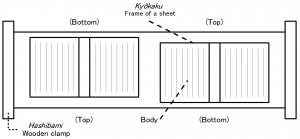
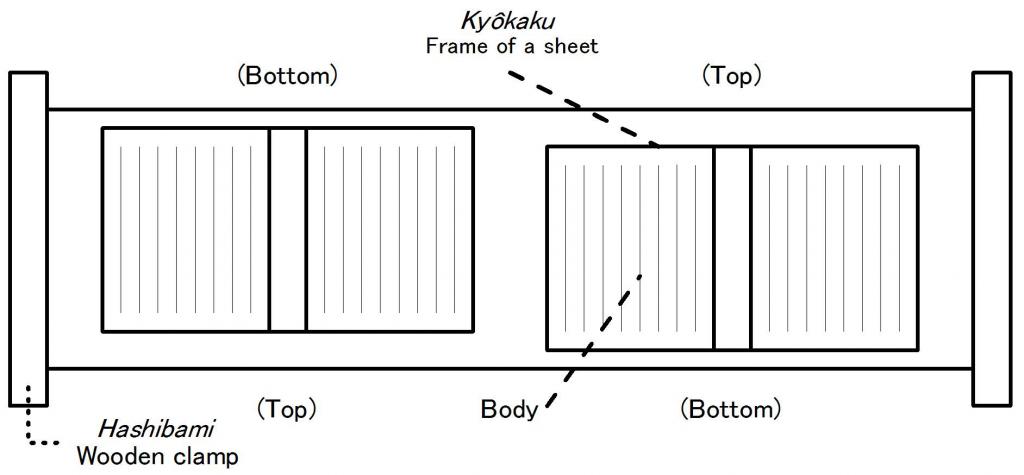
Diagram of a printing block for two double-page openings.

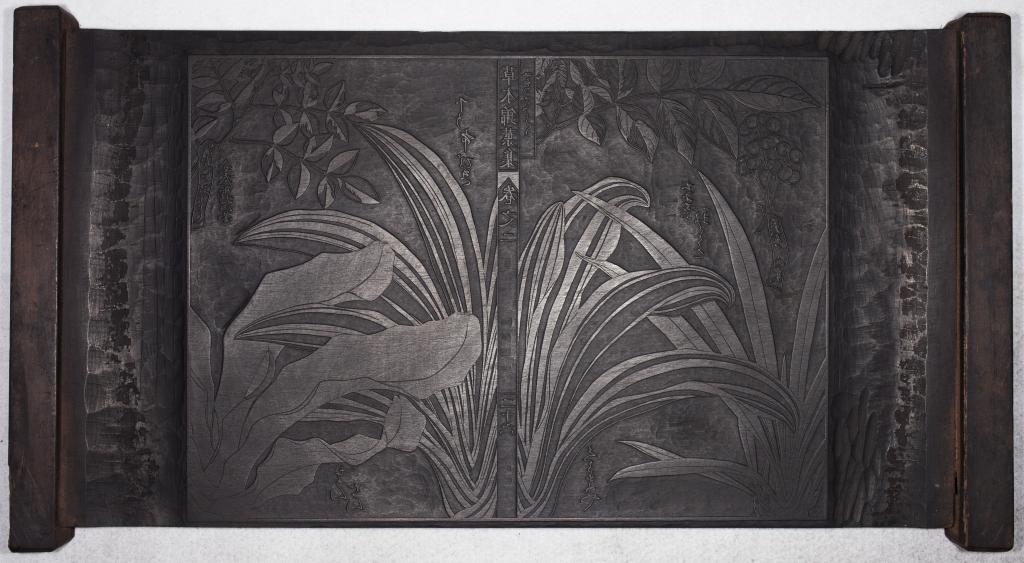
Printing block for Sōmoku kinyōshū 草木錦葉集 (Descriptions and illustrations of beautiful variegated plants), Mizuno Tadanori 水野忠敬, 1829. Collection of Unsōdō Corporation (芸艸堂), Kyoto.


Printing block for Dōmyaku sensei kyōshi gafu 銅脈先生狂詩画譜 (Master Dōmyaku's album of mad verses with paintings), Hatakenaka Kansai 畠中観斎, 1786. Nara University Museum, T1073.


Printing block for Kōan reisetsu 弘安礼節 (Civility for court nobles compiled in Kōan era), n.d. Nara University Museum, T1115.

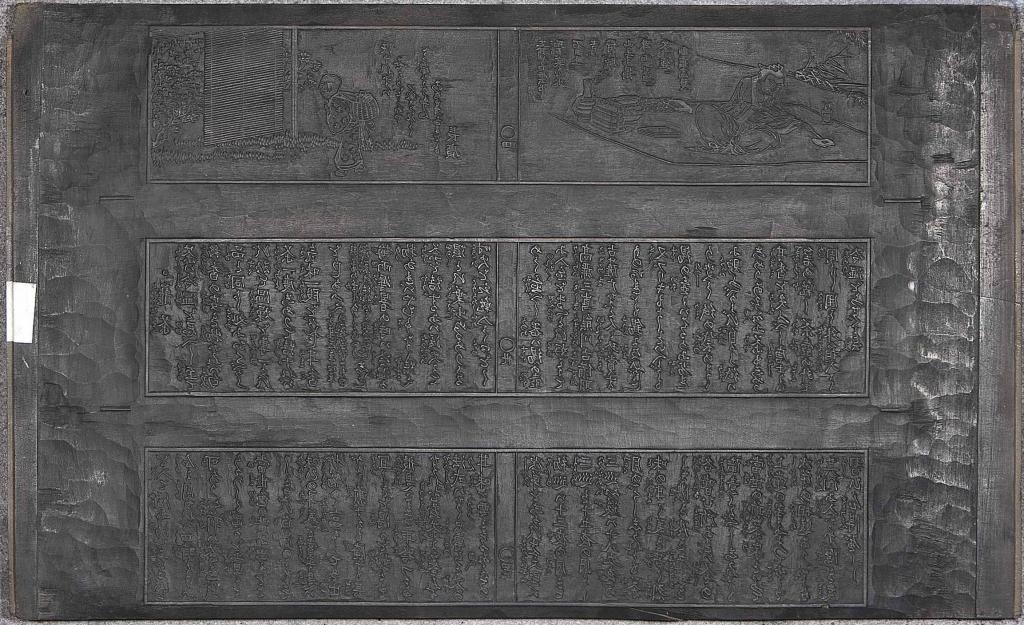
Printing block for Sencha yōran 煎茶要覧 (Sencha handbook), edited by Tōen 東園, 1851. Collection of the Fujii Bunseidō, Kyoto, F0346.
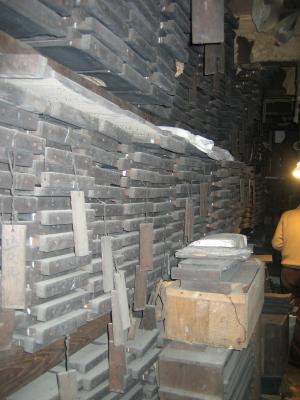
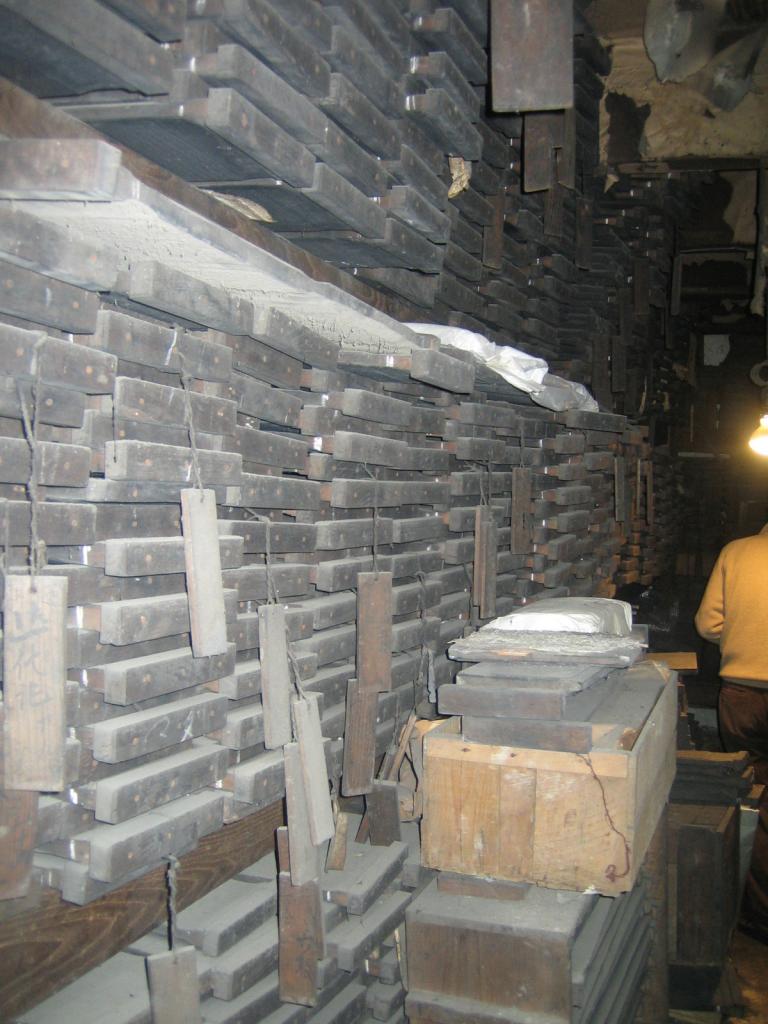
Printing block storage at the publisher Hōzōkan, Kyoto.


Printing block for Gyosan taigaishū 魚山蠆芥集 (Collections and manuals for chanting of Shingon sect chants), 1743. Nara University Museum, K0010 (detail).


Example of a convex-shaped (deko凸) hashibami (wooden clamp). Nara University Museum.


Printing block for Ehon Wakakusayama 絵本若草山 (Mount Wakakusa: an illustrated book [of customs in Kamigata]), Nishikawa Sukenobu西川祐信, 1745. Collection of Fujii Bunseidō, Kyoto, F0054 (detail).


Example of a “sliding-type” hashibami. Nara University Museum.
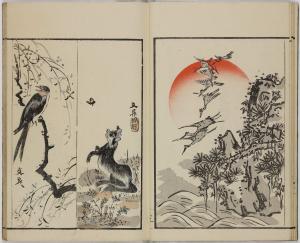
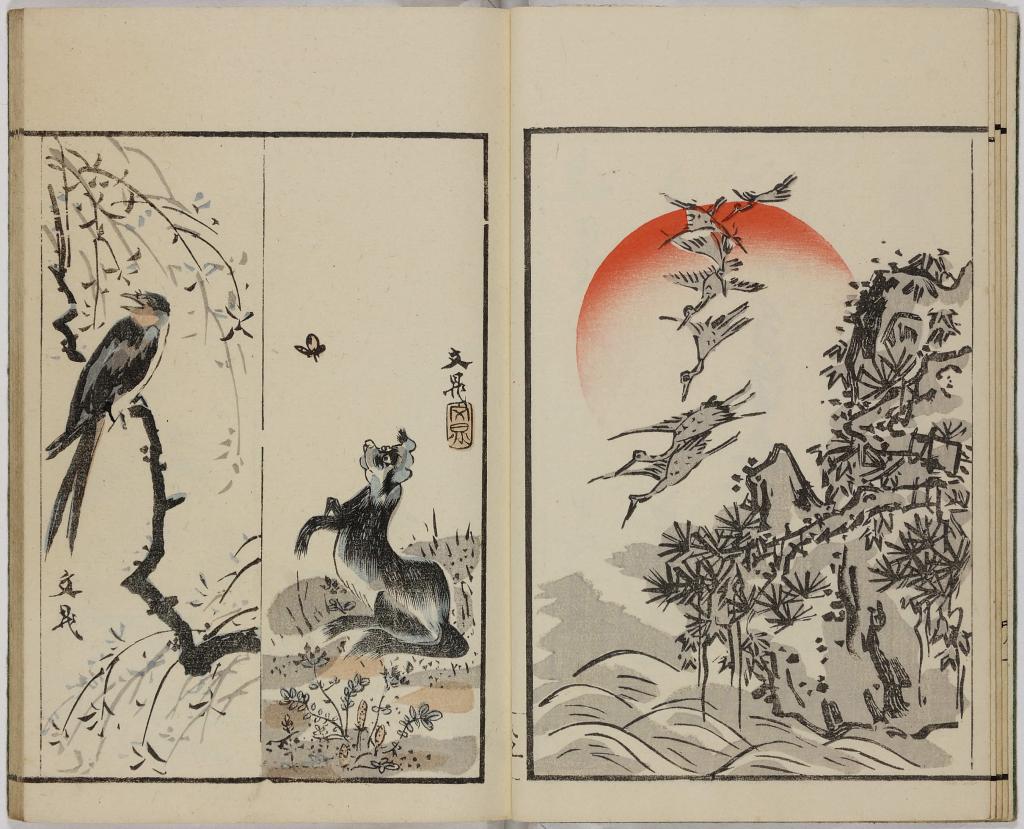
Bunchō gafu 文晁画譜 (Bunchō’s painting album), Tani Bunchō 谷文晁, 1862. Pulverer Collection, FSC-GR-780.603.
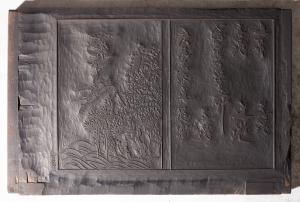
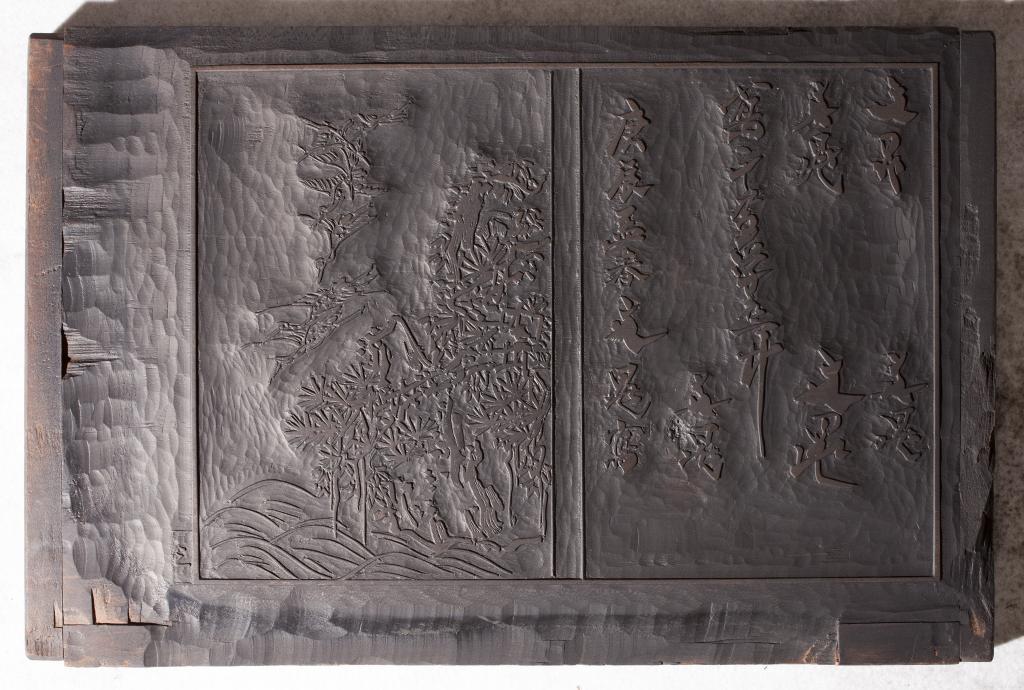
Keyblock for Bunchō gafu 文晁画譜 (Bunchō’s painting album), Tani Bunchō 谷文晁, 1862 (mirror image). Collection of Unsōdō Corporation (芸艸堂), Kyoto.
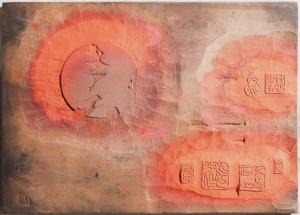
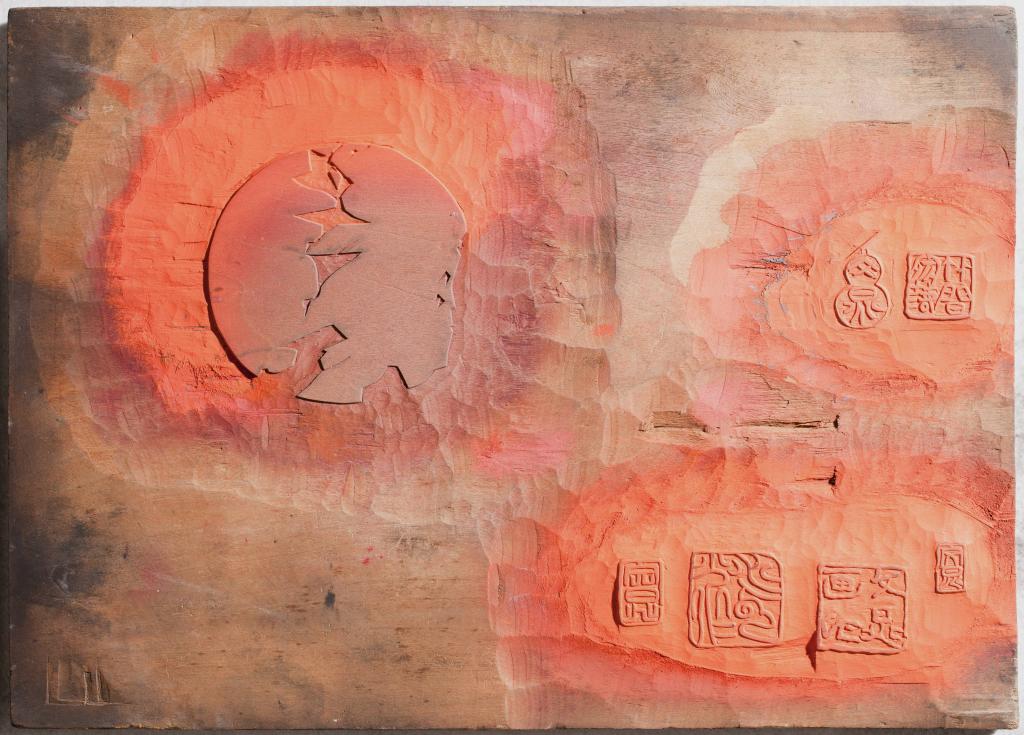
Color block for Bunchō gafu 文晁画譜 (Bunchō’s painting album), Tani Bunchō 谷文晁, 1862 (mirror image). Collection of Unsōdō Corporation (芸艸堂), Kyoto.
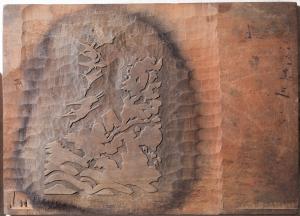
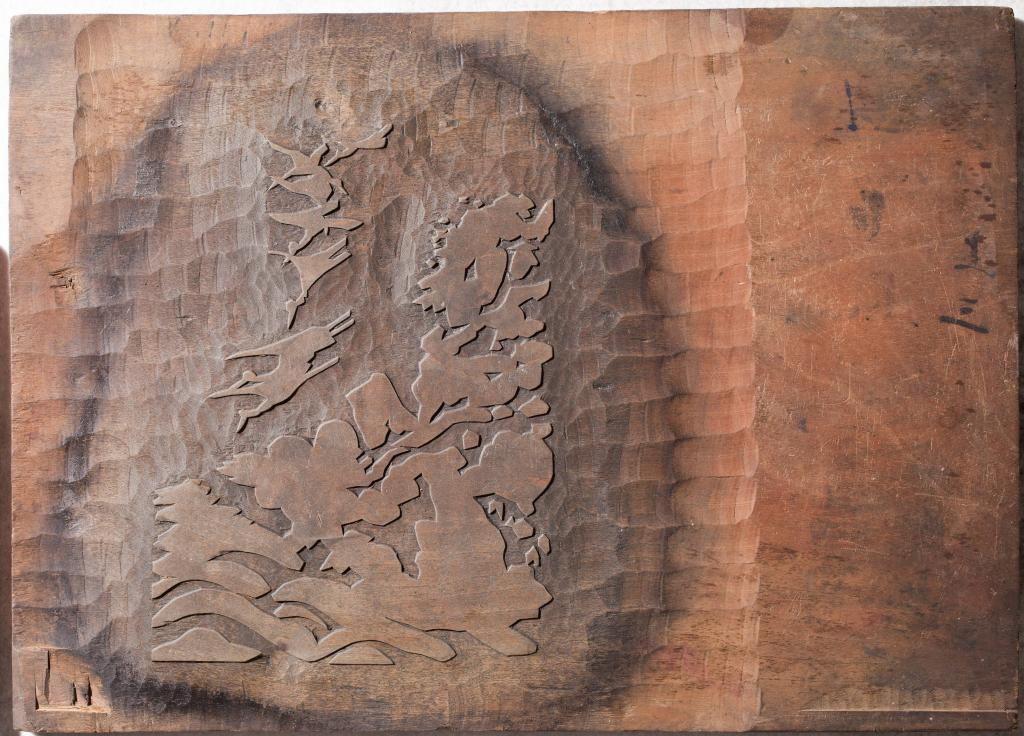
Color block for Bunchō gafu 文晁画譜 (Bunchō’s painting album), Tani Bunchō 谷文晁, 1862 (mirror image). Collection of Unsōdō Corporation (芸艸堂), Kyoto.

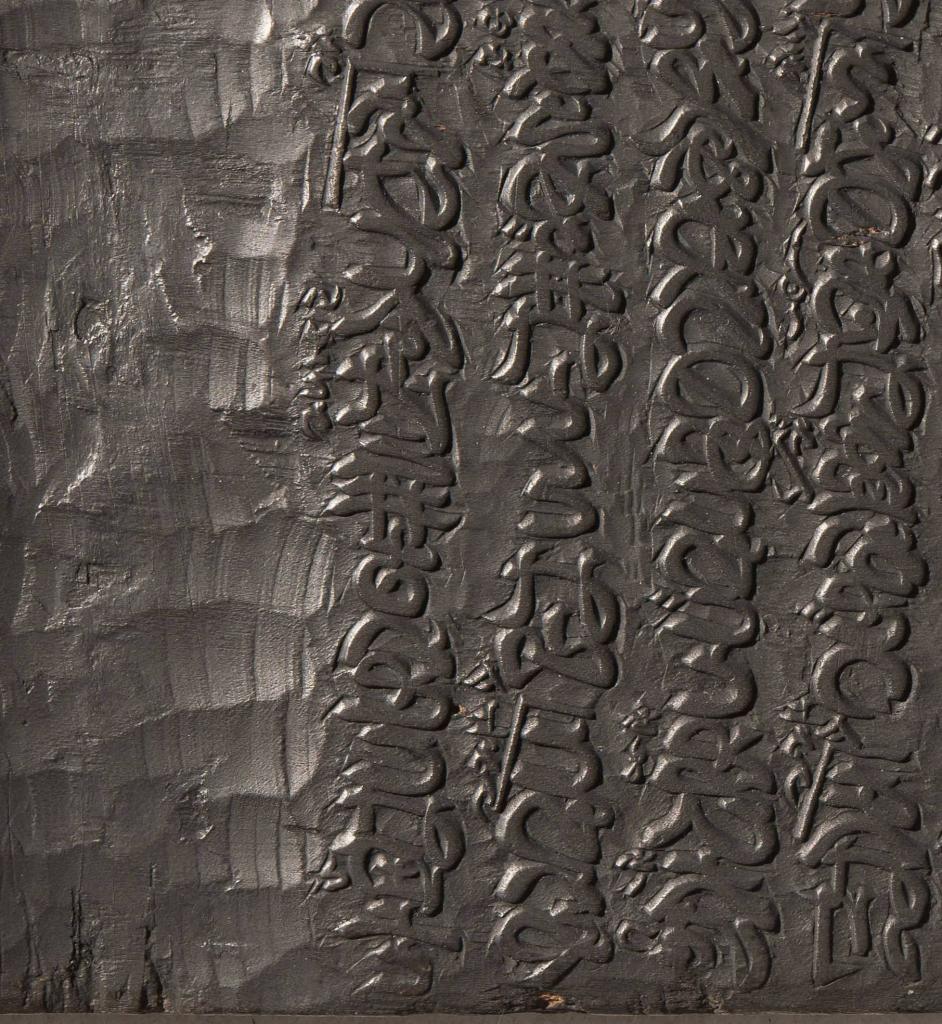
Printing block for untitled collection of nagauta songs. Private Collection (detail).
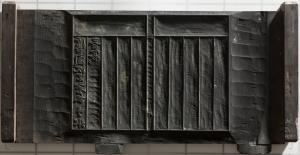
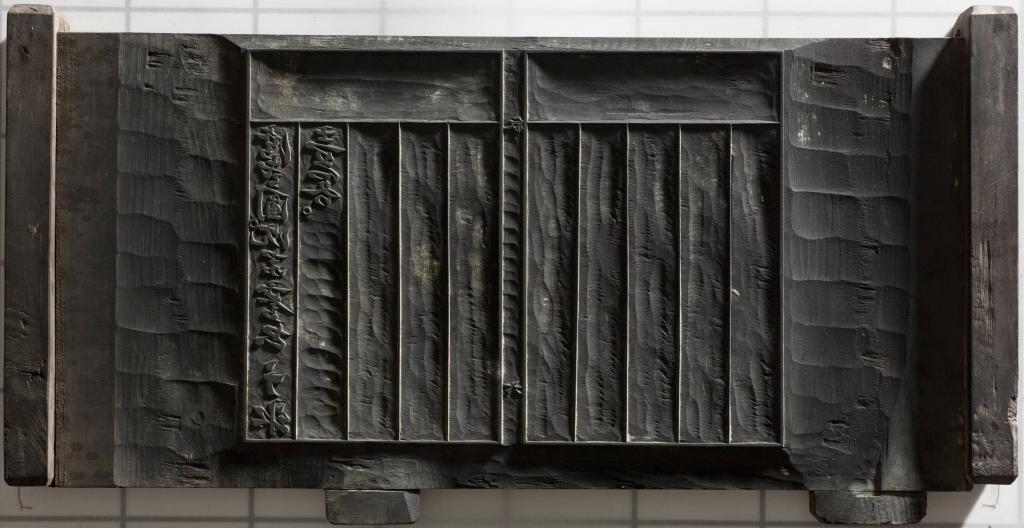
Printing block (illustrating kentō registration mark) for Kaishū gaku gahen 芥舟学画編 (A guide to the painting theories of Jie Zhou [Ch. Jie Zhou xue huabian]), annotated by Tabinoshō Chisato 田結荘千里, 1879. Nara University Museum, T3075.


Printing block before cutting. Nara University Museum, T2544.


Printing block with surface removed for re-use. Nara University Museum, T2549.
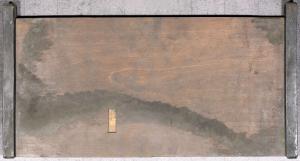

Printing block with surface treated for re-use. Nara University Museum, T2536.
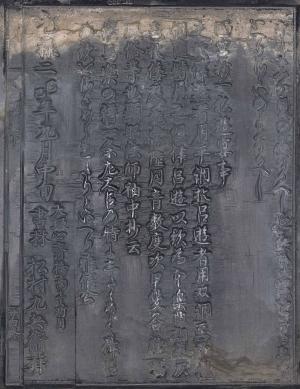
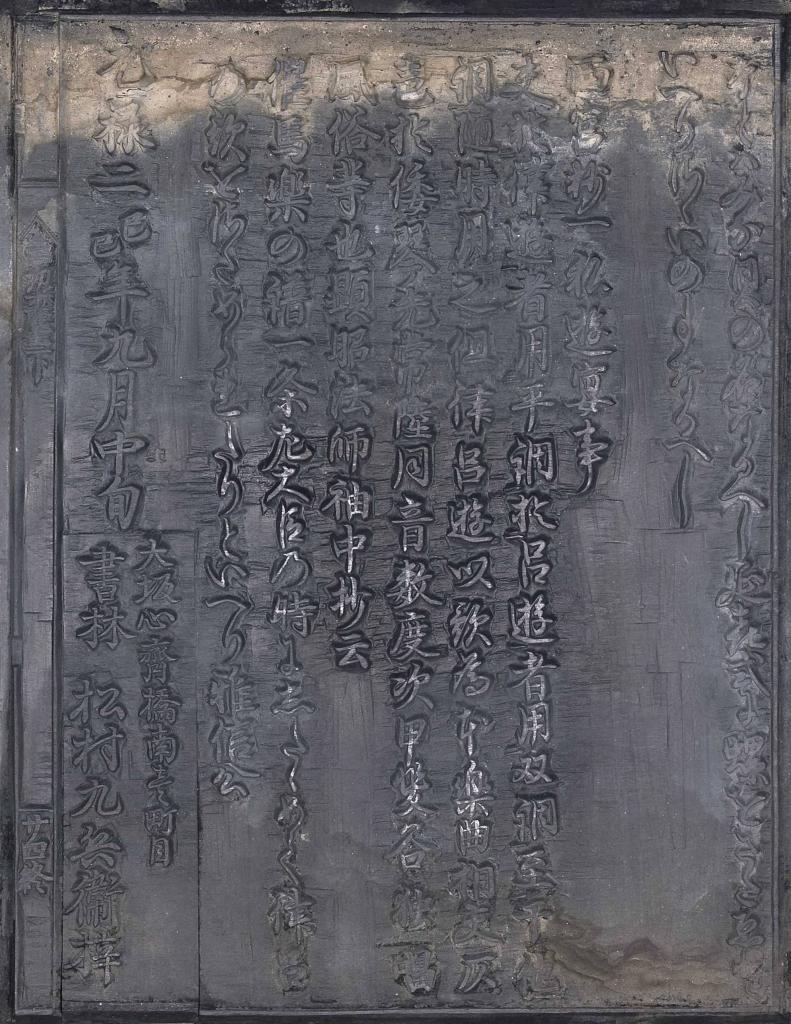
Wood plug (ireki). Printing block for Ryōjin guanshō 梁塵愚案抄 (Commentary on the Japanese court songs kagurauta and saibara), Ichijō Kaneyoshi 一条兼良, 1689. Nara University Library, T2533 (detail; reverse image).
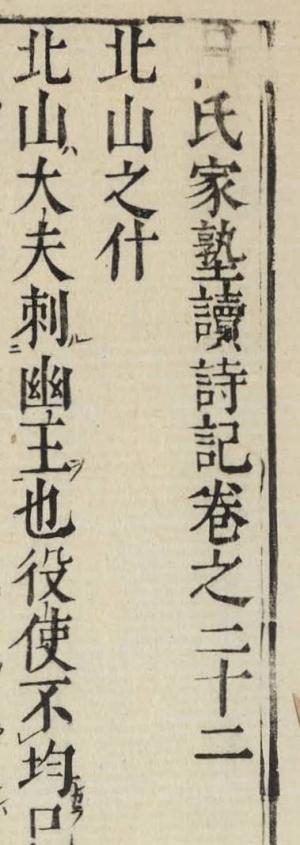
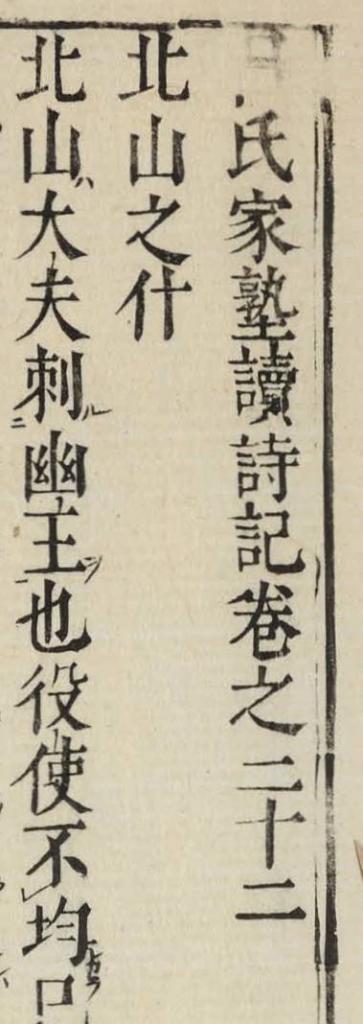
Ryoshi Kajuku dokushiki 呂氏家塾読詩記(和刻本) (Notes on verses from the private academy of Lu Zuqian [Ch. Lu Shijia shu du shiji]) (Japanese edition), 1696. Ritsumeikan University Art Research Center (ARC), Kyoto, arcBK01-0033. (detail)
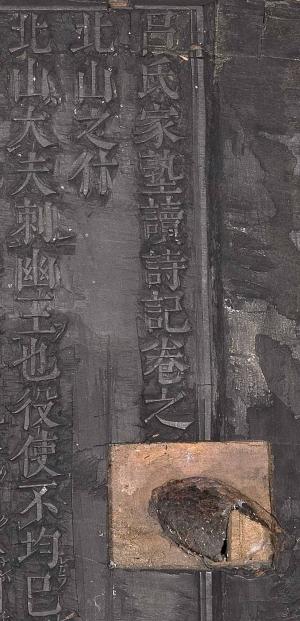
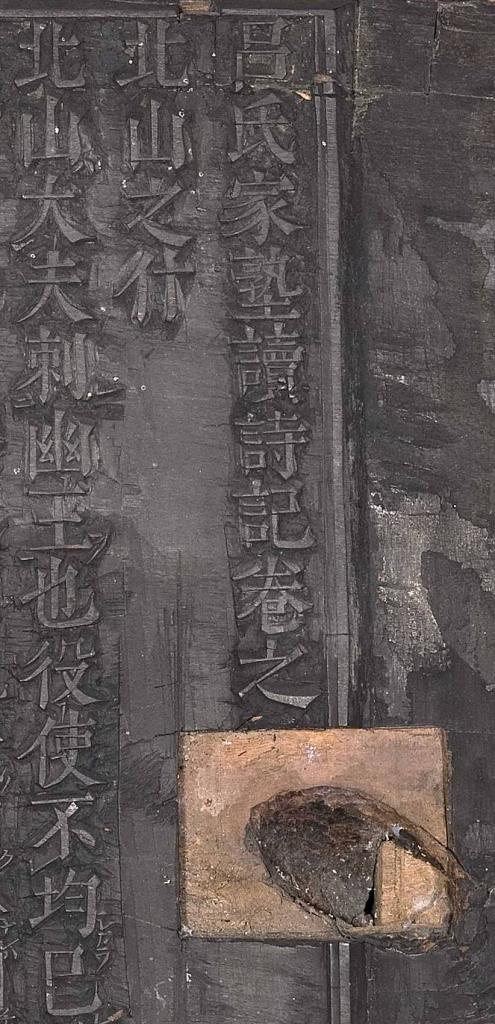
Example of using wood plugs (ireki). Printing block for Ryoshi Kajuku dokushiki 呂氏家塾読詩記 (和刻本) (Notes on verses from the private academy of Lu Zuqian [Ch. Lu Shijia shu du shiji]) (Japanese edition), 1696. Nara University Museum, T2384 (detail; mirror image).
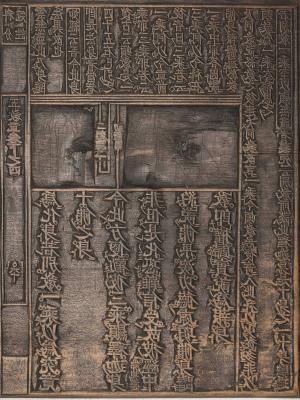
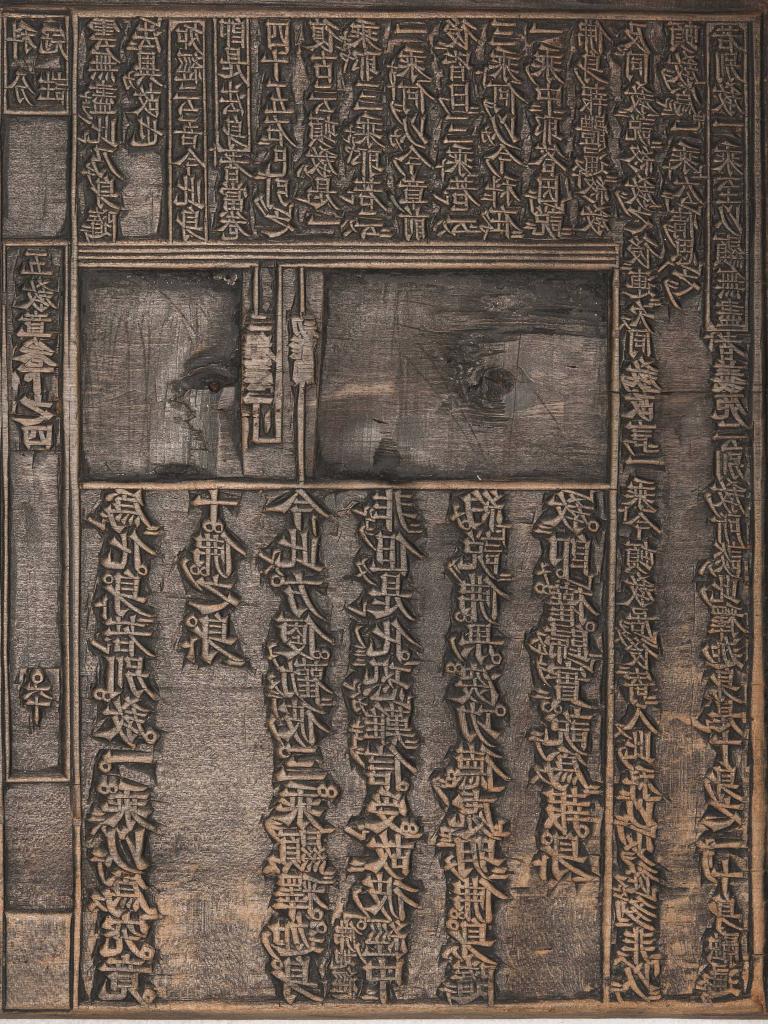
Example of a wood knot. Printing block for Kanchū gokyōshō 冠註五教章 (The headnotes of the five chapters of Huayan scripture), compiled by Hōzō, explanatory notes by Kan’ō, 1706. Private Collection (detail).
